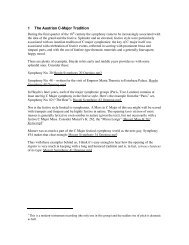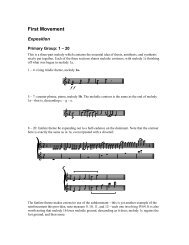Mozart Symphony No. 39 (PDF) - Scott Foglesong
Mozart Symphony No. 39 (PDF) - Scott Foglesong
Mozart Symphony No. 39 (PDF) - Scott Foglesong
You also want an ePaper? Increase the reach of your titles
YUMPU automatically turns print PDFs into web optimized ePapers that Google loves.
• Starting at 71 they’re in 3rds mixed with octaves—generally speaking they’re harmonic<br />
components, including some seconds at 77.<br />
• Usually they double the horns: see measures 90 – 97, 120 –135.<br />
2.7 Horns<br />
The horns have some interesting usage here. Most of the time they act in the traditional Classical<br />
roles, which are here illustrated from the first movement:<br />
• Sustaining pedal points (9 – 13, 97 – 105)<br />
• Reinforcing woodwind accompaniment (62 – 66)<br />
• Fleshing out chords (73 – 82)<br />
2.7.1 First Movement<br />
• 27 – 30 the horns are both counter-melody and an echo of the melody. They aren’t actually<br />
continuing the melody; the change in sonority (with violin 1 holding onto its pitch) prohibits<br />
that. Proof’s in the pudding: I - 26 - 33.mp3. I’ll agree that it’s a very noticeable sonority—<br />
but I don’t think it’s melodic. (Besides the treatment at the repeat in the next part of the<br />
phrase makes that clear enough.)<br />
• 54 – 61 they’re a doubling of the main melody, which seems to take over at 60; the violins<br />
move in a middle register while the horns are pretty high. The result is that the horns really<br />
have the show here.I - 54 - 61.mp3<br />
• 158 – 159 they’re slightly canonic with the winds.<br />
2.7.2 Second Movement<br />
Seems the best place to note a misprint in the Dover score: measure 133 (page 162, 3 rd measure)<br />
contains a spurious bass clef; the horns can’t play that low! The passage should remain in treble<br />
as written.<br />
2.8 Bassoons and Horns<br />
2.8.1 First Movement<br />
An intriguing bit of orchestral practice encountered in 26 – 33. The melody is answered in the<br />
horns, and then in the bassoons. The change in sonority is considerably more subtle than one<br />
might think: I - 26 - 33.mp3. Definitely noticeable; the bassoons are more pungent, more nasal.<br />
In measures 40 – 47 the original phrase is repeated, but this time the answering echo is played<br />
first in paired clarinets, then clarinet 1 coupled with flute at an upper octave. The effect is<br />
astonishing: I - 40 - 47.mp3. The counter-melody/echo is now above the strings, and is treated<br />
with that same sense of coolness/pungency of the horn-bassoon combo. So there is a sense here<br />
that a change from paired horns to paired bassoons is emotionally similar to a changed from<br />
paired clarinets to clarinet + flute.





